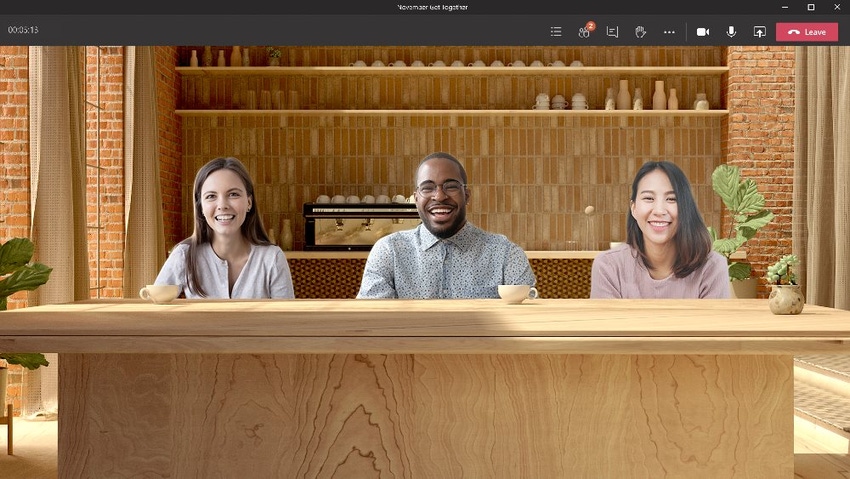Together mode simulates participants in collective work or classroom environments.
July 9, 2020

New Microsoft Teams features, including “Together Mode,” set to roll out soon, will potentially eliminate the status quo and fatigue of online video meetings.
Microsoft Teams meetings will offer a more natural experience with this month’s release of Together Mode, the company revealed Wednesday.
Together Mode is an alternative to the common approach of presenting meeting participants in square tiles, in grid-like galleries. Instead, Together mode simulates them in more realistic context.
We broke down 12 new Microsoft Teams virtual meeting features. |
Initially, Together Mode will render meeting participants in auditoriums or classrooms, with leaders or teachers at a lectern. It will do so with what Microsoft calls segmentation technology, using artificial intelligence to digitally place participants in a shared background.
Among other new Microsoft Teams capabilities in the pipeline are dynamic views and speaker attribution for live captions and transcripts. Also coming are chat bubbles to surface messages more clearly, an enhanced whiteboard and an integrated tasks app.
But Together Mode is the most significant addition, according to Microsoft, because it will enable more engaging virtual meetings. On the surface, it may appear as the latest gimmick to move beyond custom backgrounds.
However, since COVID-19 has confined workers and students to their homes, millions of people have relied on video meeting services. While Microsoft Teams, Zoom and others have helped bridge the gap, 60% feel less connected, according to a Microsoft survey.
“Together Mode makes you feel like you’re sitting in the same room as everyone in the meeting,” said Microsoft corporate VP Jared Spataro, during an online briefing with media and analysts. “It also enables human social connection, including making eye gaze to feel more natural. And it makes it easier for people to take turns speaking.”
A Lasting Trend
As many workers return to their offices, online meeting services will remain a core part of collaboration, Spataro added.
“We see this shift to fluid work and workspaces not as passing trend, but as a durable or lasting shift,” he said.
Spataro emphasized that Microsoft’s research backs this claim. For example, in countries where workplaces have reopened, the number of active Teams users continues to rise. Among them are China, New Zealand and South Korea.
“People also continue to turn on their video two times more than before at 46% of all meetings,” Spataro said. “Among education customers, this number jumps to around 70%.”
Together Mode will start to appear with other new Microsoft Teams features during the coming weeks, the company revealed.
Some are already available. Among them are support for up to 49 participants in a meeting, a number set to rise to 1,000. Meeting participants can also filter out background nose and blur their backgrounds, among other new Microsoft Teams features.
Even prior to the pandemic’s now enduring impact on the workplace, Microsoft had identified Teams as its most strategic offering. Now with dozens of online video meeting platforms available, Microsoft wants to make Teams the preferred choice.
Microsoft’s stiffest competition comes from …
… Zoom, which has become a default choice for many businesses and consumers alike. Earlier this week, Zoom expanded its partnerships with videoconferencing hardware providers.
At the beginning of the pandemic, Zoom usurped Microsoft with support for more meeting participants and a user-friendly interface. Zoom also jumped out early with its free tier of service.
Every provider with a meeting platform – including Avaya, Cisco, Google and LogMeIn’s GoTo – has experienced exponential growth since the pandemic struck.
The number of Microsoft Teams users has grown at least quadrupled. By its most recent count in late April, there are 75 million Teams users.
Latest Round in the Arms Race
Together Mode and other new Microsoft Teams features will stand out against rivals, at least initially, according to industry experts.
“These are the arguably the first features that allow Microsoft to jump ahead of its competitors rather than play catch-up,” said analyst Irwin Lazar, VP and service director for the digital workplace practice at Nemertes. “I think Together Mode could improve meeting experiences and remove distractions from virtual backgrounds,” Lazar said.
Lazar believes the speaker attribution is also a critical new Microsoft Teams addition.
“Our research shows that transcription is the most desired meeting feature by meeting app buyers,” he said.
The pandemic has created an “arms race’ between Microsoft and Zoom, said Scott Gode, CMO at Unify Square. Initially a managed services provider focused on Skype for Business, and now Teams, Unify Square is also a Zoom partner.
“From a bits and bytes technical perspective, they’re probably more at par but optically in some people’s minds, Zoom has leapfrogged them,” Gode told Channel Futures. “With Microsoft’s latest set of announcements, I think they’re going to do the leapfrogging in this arms race. It is clear they’ve thought through how people are using the product or how they want to use it.”
Digital Remote Learning
Particularly promising are the new Microsoft Teams features added for remote learning, revealed last month, according to Gode. Microsoft aims to enhance the classroom experience in Teams that give more controls to teachers and instructors. Among them, instructors can prevent students from attending Teams classrooms without permission and control who can present.
Teams will also let students more visibly raise their hands, and it will provide instructors with attendance reports and analytic dashboards on that can gauge student performance.
Many school districts will continue to use remote learning this fall, according to 500 teachers and administrators Microsoft surveyed. The survey findings show that 61% expect to rely on a mixture of classroom and remote learning.
The new Microsoft Teams capabilities promise to give the company’s partners added consulting and integration opportunities. Microsoft is persuading partners to remind customers that Teams is part of their Microsoft 365 and Office subscriptions.
Microsoft gold partner SoHo Dragon is among those that have enjoyed the spike in Microsoft Teams implementations. CTO Peter Ward believes Microsoft Teams is a more attractive option for virtual meetings than Zoom.
“The big complaint people have with Zoom is that everyone’s just basically Zoomed out,” Ward said. “Now that it’s about to become more interactive, a key challenge with Teams is gone. I think the only thing that competes with Microsoft Teams now, is face-to-face meetings.”
Read more about:
AgentsAbout the Author(s)
You May Also Like


